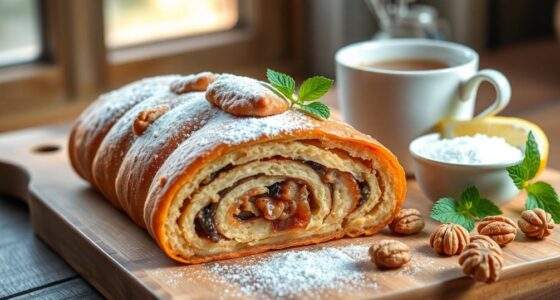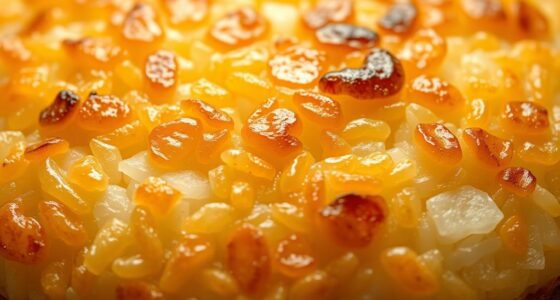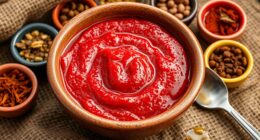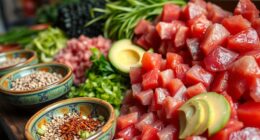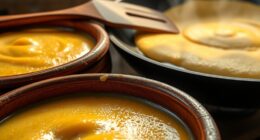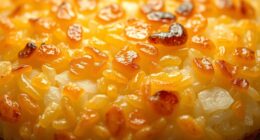In Thai mango sticky rice, coconut chemistry plays a key role in creating its signature flavor and creamy texture. The coconut milk’s fats and sugars blend with rice during cooking, making it tender and silky, while enhancing aroma and sweetness. Effective emulsification guarantees smoothness, and the fats penetrate rice grains for added tenderness. The balanced interaction with fresh mango’s sugars and acidity completes the harmonious flavor profile. To understand how these elements come together perfectly, keep exploring further.
Key Takeaways
- Coconut milk’s fats create a creamy, silky texture and enhance flavor by carrying aromatic compounds.
- Medium-chain triglycerides in coconut fats melt at body temperature, contributing to mouthfeel and flavor absorption.
- Proper emulsification of coconut milk and rice ensures a smooth, cohesive, and creamy sticky rice consistency.
- Coconut fats penetrate rice grains, improving tenderness while preventing excessive water absorption for ideal texture.
- Mango’s sugars and acidity balance coconut’s richness, creating a harmonious flavor profile through chemical interactions.
The Role of Coconut Milk in Flavor and Texture
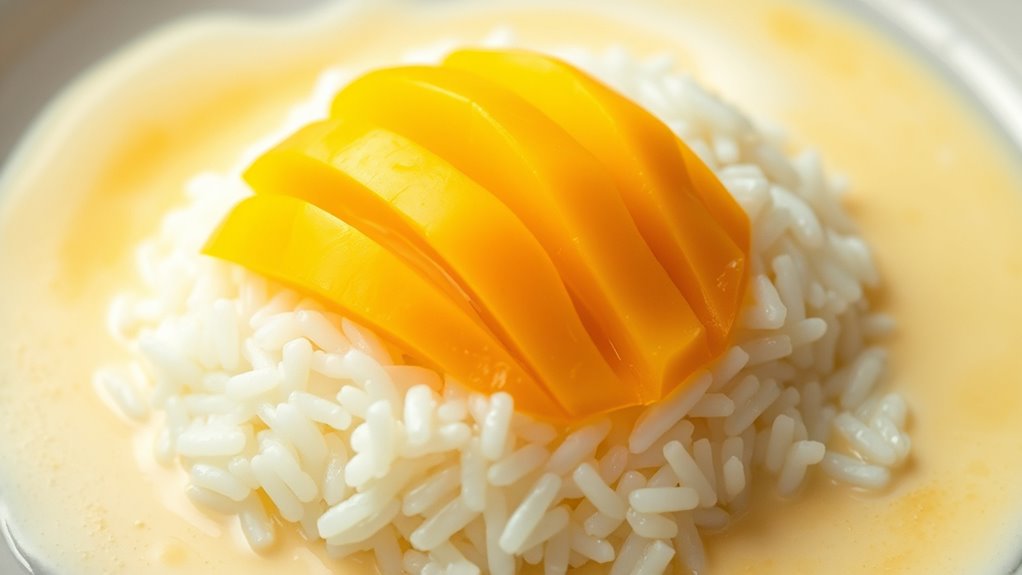
Coconut milk is essential to Thai mango sticky rice because it imparts a rich, creamy flavor that perfectly complements the sweetness of the mango and the chewiness of the rice. When you cook the rice with coconut milk, it absorbs the liquid, becoming tender and infused with its delicate aroma. This creates a smooth, luscious texture that makes each bite satisfying. The natural fats in the coconut milk also enhance the rice’s mouthfeel, giving it a silky quality. As you stir the mixture, you’ll notice how the coconut’s subtle sweetness melds with the rice, adding depth to the dish. Additionally, the calibration of coconut milk can influence the overall flavor balance, making each serving uniquely delicious. Proper storage of coconut milk ensures its freshness and flavor retention over time. Maintaining the right consistency of coconut milk during cooking helps achieve the ideal texture for the dish. This harmonious blend of flavor and texture is what makes Thai mango sticky rice truly irresistible.
Lipids and Sugars: The Chemistry of Coconut Fats

The fats and sugars in coconut milk play a vital role in shaping the dish’s rich flavor and smooth texture. Coconut fats are primarily composed of medium-chain triglycerides, which melt at body temperature, giving your sticky rice its luscious, creamy feel. These fats also carry flavor compounds, enhancing the nutty, sweet aroma of coconut. Sugars in coconut milk, mainly in the form of natural glucose and fructose, add subtle sweetness that balances the fruit’s tanginess. Together, lipids and sugars influence how the rice absorbs flavors and achieves its tender consistency. The fats provide a velvety mouthfeel, while the sugars contribute to the overall sweetness and depth. The presence of sustainable ingredients in coconut milk further supports eco-friendly choices in cooking. Additionally, the lipids and sugars’ moisture retention properties help maintain the rice’s ideal texture during preparation. Moreover, understanding the AI security concerns related to data integrity and safety can inform better practices in food technology and digital culinary innovations. This chemistry creates the harmonious balance that makes Thai mango sticky rice so irresistibly indulgent.
Emulsification and Creaminess in Sticky Rice
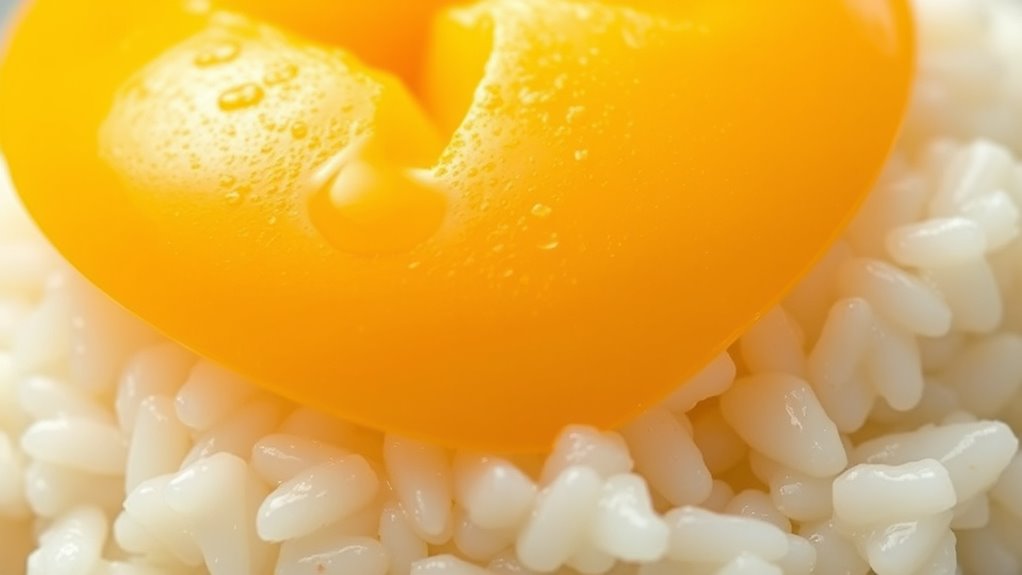
Achieving the signature creaminess of Thai mango sticky rice hinges on effective emulsification, where fats and liquids blend seamlessly to create a smooth, velvety texture. When done correctly, the fats from coconut milk bond with the rice’s starches, resulting in a cohesive, luscious dish. To enhance this process, focus on:
Achieve creamy Thai mango sticky rice by mastering emulsification with coconut milk and proper mixing techniques.
- Stirring continuously during cooking to promote uniform fat distribution.
- Using the right ratio of coconut milk to rice, ensuring enough fat content for smoothness.
- Allowing the rice to rest after cooking, giving the fats time to fully integrate and settle.
- Understanding the culinary chemistry behind emulsification can help optimize texture and flavor. Additionally, controlling the temperature during cooking can significantly affect the stability of the emulsion and the final creaminess.
These steps help create a stable emulsion, preventing separation and boosting creaminess. Proper emulsification ensures every bite is rich, silky, and perfectly balanced with the natural sweetness of mango.
The Interaction Between Coconut Components and Rice
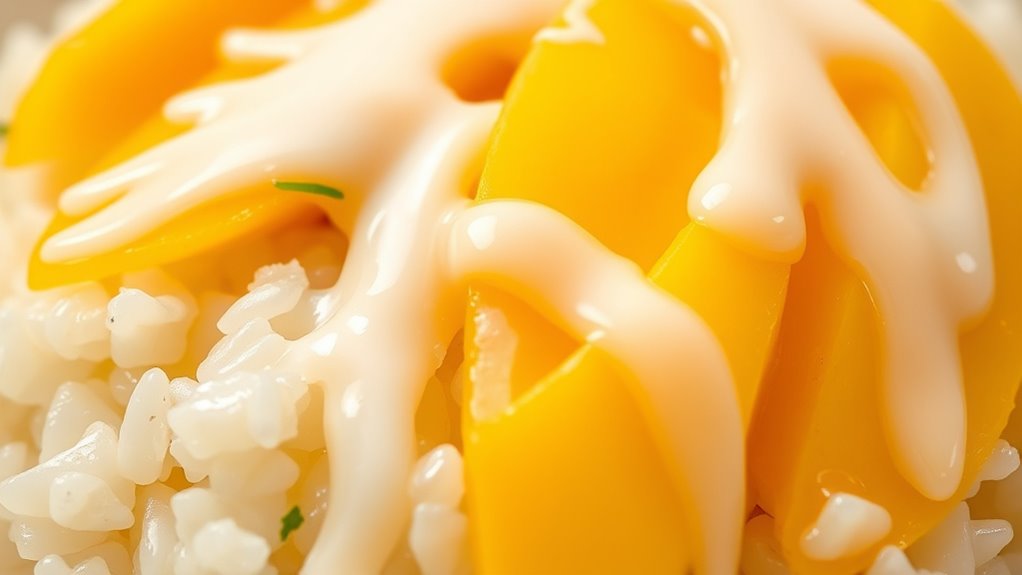
As the coconut components interact with the rice, their fats and starches work together to create the dish’s signature texture. The fats from coconut milk penetrate the rice grains, making them tender and adding a rich, silky mouthfeel. Meanwhile, the starches released from the rice during cooking form a gentle, glue-like coating, helping the grains stick together without becoming mushy. This balance produces a cohesive yet tender consistency that’s both creamy and slightly chewy. The coconut fats also inhibit excessive water absorption, ensuring the rice remains moist but not overly sticky. Additionally, understanding cybersecurity vulnerabilities during food preparation can help prevent digital threats in modern culinary environments. Incorporating proper food safety practices is essential to maintain the quality and safety of the dish in professional settings. Being aware of safety protocols can further protect both the chef and the consumers. Moreover, employing modern kitchen technology can enhance the cooking precision and consistency of traditional recipes. As a result, the rice achieves a harmonious texture that perfectly complements the sweet coconut flavor and the overall sensory experience of Thai mango sticky rice. Attention to the process can enhance the overall quality and enjoyment of the dish.
Mango’S Contribution and Its Chemical Harmony With Coconut
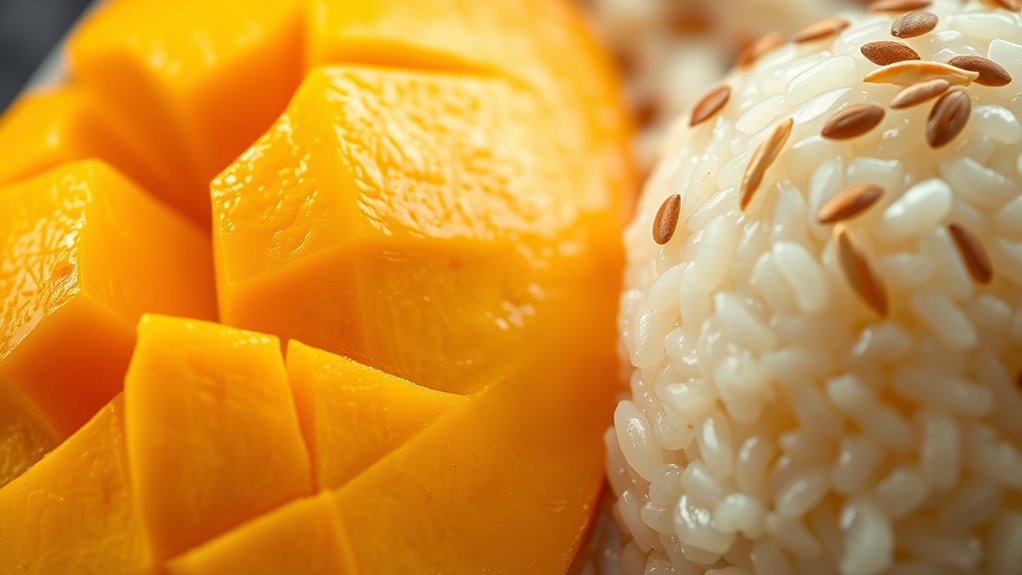
Mango’s vibrant sweetness pairs perfectly with the rich, creamy coconut in Thai mango sticky rice, creating a harmonious flavor balance. The natural sugars in mango complement the coconut’s smooth, fatty profile, enhancing the dessert’s overall taste. This synergy is thanks to the chemical harmony between the fruit’s sugars and the coconut’s fatty acids, which amplify each other’s flavors.
- The high sugar content in mango elevates the perception of coconut’s richness, balancing the dish.
- Mango’s acidity cuts through the creaminess, adding freshness and preventing heaviness.
- The aromatic compounds in mango, such as terpenes, blend with coconut’s subtle scent, creating a unified flavor profile.
- The presence of natural antioxidants in mango and coconut can contribute to overall health benefits, supporting well-being.
- The chemical interactions between mango’s sugars and coconut’s fats enhance the overall flavor harmony of this traditional dessert.
Together, they produce a delightful, well-rounded taste experience.
Frequently Asked Questions
How Does Coconut Milk Influence the Nutritional Value of Mango Sticky Rice?
Coconut milk substantially boosts the nutritional value of mango sticky rice by adding healthy fats, which provide energy and support cell function. It also supplies essential minerals like manganese and magnesium, contributing to bone health and metabolism. However, it increases the calorie content, so you should enjoy it in moderation. Overall, coconut milk enriches the dish with flavor and nutrients, making it more satisfying and nutritious.
What Are the Common Chemical Changes During Coconut Milk Heating?
When you heat coconut milk, you cause chemical changes like protein denaturation and fat breakdown. These processes occur as heat causes proteins to unfold and fats to separate or emulsify, altering texture and flavor. You might notice a thickening or slight curdling, which results from these reactions. Heating coconut milk enhances its aroma and flavor but also changes its chemistry, impacting how it interacts with other ingredients in dishes like mango sticky rice.
Can Coconut Fats Affect the Preservation and Shelf Life of Sticky Rice?
Coconut fats can influence the preservation and shelf life of sticky rice by affecting its moisture content and microbial growth. When coconut fats are present, they create a barrier that slows moisture loss, helping the rice stay fresh longer. Additionally, the fats have antimicrobial properties that may inhibit mold and bacteria development. However, if the fats oxidize, they can lead to spoilage, so proper storage is essential.
How Do Different Varieties of Mango Alter the Chemical Harmony With Coconut?
Imagine a symphony where each instrument perfectly complements the others. Different mango varieties bring unique levels of acidity, sugar, and aroma, which interact with coconut’s rich fats. You’ll notice that some mangoes create a balanced, harmonious blend, while others might overpower or clash with the coconut’s creamy texture. These chemical differences influence flavor, aroma, and overall taste, making each pairing a new, delightful experience.
Are There Health Benefits Linked to the Coconut Chemistry in This Dessert?
You might wonder if the coconut chemistry in this dessert offers health benefits. Well, coconut contains healthy fats called MCTs, which can boost energy and support brain health. It also has antioxidants that fight inflammation. Eating coconut in moderation can help improve your cholesterol levels and provide essential nutrients like vitamins E and B. So, enjoying this dessert not only satisfies your sweet tooth but also offers some nutritional perks.
Conclusion
You’ll find that the perfect Thai mango sticky rice balances coconut’s rich lipids and sugars, creating a luscious, creamy texture. Did you know that coconut milk contains up to 24% fat, which enhances flavor and mouthfeel? By understanding how coconut components interact with rice and mango, you can truly appreciate the science behind this beloved dessert. So, next time you enjoy it, remember the fascinating chemistry that makes it so irresistibly delicious.



